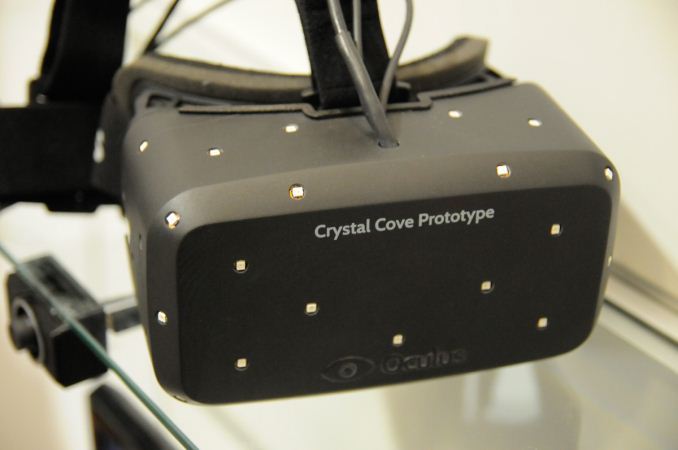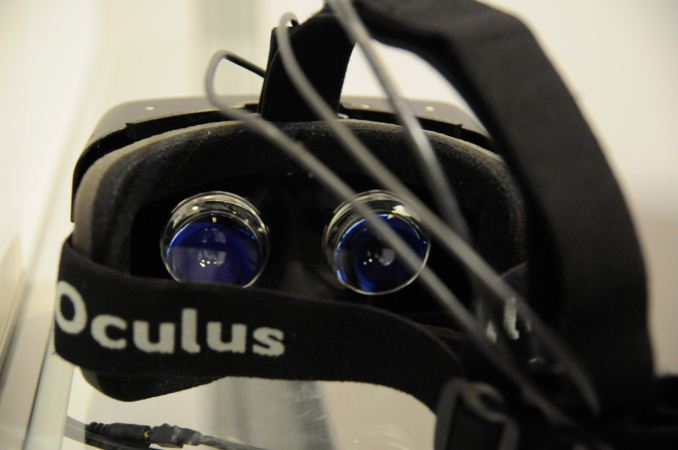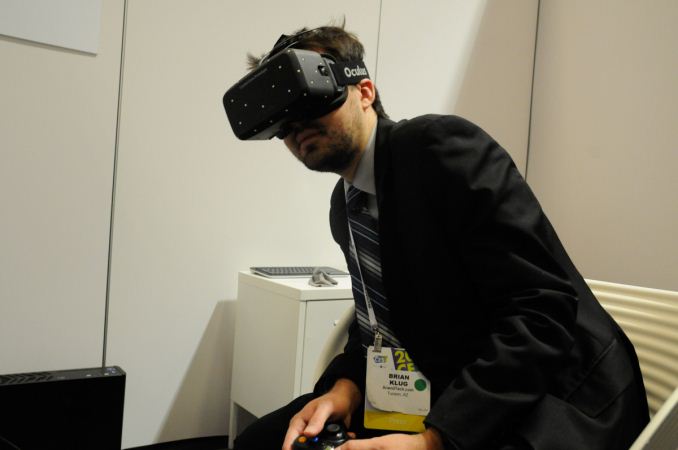Eyes On With the Oculus Crystal Cove Prototype
by Brian Klug on January 10, 2014 4:25 PM EST- Posted in
- Trade Shows
- CES
- Oculus Rift
- CES 2014

Last year, one of the most intriguing and hotly anticipated things I saw at CES was the Oculus Rift. Although the hardware was still early, and the display not the highest resolution, the demo was the most convincing virtual reality experience I had experienced to date by a long margin. The combination of an adequately fast and accurate IMU (inertial measurement unit), the right kind of tuning, and adequately immersive demos made the Oculus experience really the first credible experience.
At this years CES, Oculus is back again with a newer version, codenamed Crystal Cove, which is a much more polished (but still not final) unit with a number of planned improvements. First and arguably most important is positional tracking, which utilizes a number of infrared LEDs mounted all over the front of the chassis and a camera ahead of the unit to track the position of Oculus, and in turn the wearer's head. This enables the unit to track and move the camera around as a wearer leans or moves their head. This increases immersion by allowing you to lean closer to and inspect objects in the game world around you. At the same time, positional tracking helps mitigate one of the biggest factors that contributed to disorientation in the previous versions that only tracked orientation of the head. Without positional tracking, the result is that the image presented to the visual system (your eyes) no longer matches the stimuli being fed to your brain by the inner ear, since you naturally move your head around while looking at things instead of just pivoting your head with the shoulders held fixed in place.
The positional tracking system was impressively robust, correctly tracking subtle movement of the goggles even with my head facing nearly opposite the camera. It's clear that Oculus has provided enough target LEDs for tracking the goggles in a robust fashion. In addition, the the demos I tested failed gracefully when the system finally lost positional tracking, de-saturating the scene to signal to the viewer that tracking was lost and only the inputs from the IMU persisted for movement. Tracking was smooth and range was impressive as well, I could lean all the way forwards and left and right without moving out of range.
The other improvement is to the display and image quality presented to the user. Part of delivering a credible VR experience is fast refresh with minimal latency and image persistence, something the previous version I had seen admittedly struggled at (persistence especially). Moving your head around needs to be low latency, low judder, and more importantly not smeared by hysteresis from pixel response.
The display resolution itself has increased since last I saw it, from (1280x800) WVGA to 1080p. In addition, the panel type has changed from LCD to OLED, which has much faster pixel response time (~20 ms for a typical backlit LCD compared to as low as 1/1000 ms for OLED) and minimal image retention. Oculus seems to still be constrained by the current status of the mobile display market, given the 5-6 inch size of the display and desired resolution, but it's obvious that eventually they'll move their own custom panels given adequate volume. While the OLED display does have minimal smear and excellent response time, I did notice the presence of a non-RGB subpixel matrix, PenTile (RG,BG), which was distracting. I still want higher resolution, and I'm sure Oculus does as well.
Oculus also has a low persistence mode that flashes the incoming frame briefly and blanks the display in-between, which results in smoother movement without the human visual system perceiving judder from the frame being displayed continually until a new one appears. The brain fills in the gaps between frames and the result is an increased perception of smoothness. Oculus demonstrated the system with this low persistence mode enabled and disabled, I wouldn't say the effect is dramatic but definitely improves the experience when you're moving your head quickly.
In addition the Crystal Cove has a new optical system and correspondingly better glass and viewing angles, which improve peripheral vision considerably.
Oculus showed off two games, the first was a space-based dog fighting game called EVE Valkyrie, built by the same developers and set in the same universe as EVE Online. The second was a tower defense game demo from the Unreal Engine 4 development kit (UDK). Both performed very well and integrated natively with positional tracking.
Oculus remains the most compelling virtual reality experience I've experienced to date and a product to watch. The addition of positional tracking dramatically improves the experience, and lower image retention from using OLED both work together to dramatically reduce the disorientation that was common with earlier development kit units.


















17 Comments
View All Comments
Krysto - Sunday, January 12, 2014 - link
I'm curious what are Brian's thoughts on this since he actually tested it. Assuming they won't delay it more than a year, would he like in the consumer version to have a 1440p resolution (~2x the pixels), or 120 Hz?And also not sure what OLED screen they used, but let's assume they will be using Samsung's Galaxy S4 panel, which I think was much better at the whole sub-pixel arrangement thing than previous versions? I doubt we'll see true RGB in OLED anytime soon, so that's as good as we're going to get.
I'm leaning towards 120Hz rather than 1440p, and maybe jump to 1440p after 2 more years, when those panels should be cheaper, too.
I don't think they would do both at the same time even if they could this year. It's already starting to take a big toll on GPU performance. Assuming the standard for PC gaming is 30fps and 1080p resolution and a certain graphics level, with Oculus you'd get 2x more required for 3D, another 2x for 60fps already, and then another 2x for 120fps, and if you want 1440p, another 2x or so.
So with 3D enabled by default (2x), 120fps (4x), and 1440p(2x), that's a whooping 16x performance requirement needed just to play today's games properly. That's why I think they will choose only one of the two: 120hz or 1440p, and then it's "only" 8x difference, which could probably be matched in 5 years time or so (meaning we can play games on Oculus in 2019 that are of as good quality as today's great-looking PC games).
I for one don't mind, because Oculus makes everything feel a lot more real, even if technically the graphics will be about an order of magnitude worse.
Edward Peek - Sunday, January 12, 2014 - link
I just wanted to point out that the 3D in the Oculus is done at half-res so there isn't nearly a 2x hit there. Even so, a 4-8x performance gap is going to be difficult to swallow for the average gamer.mkozakewich - Tuesday, February 4, 2014 - link
The pixel count isn't as important as the screen-door effect, either. If they can just reduce the size of the space between pixels (slightly-bigger pixels in the same physical space), things will look much better.chrysrobyn - Sunday, January 12, 2014 - link
I don't actually care about the inertia or positional tracking or even 3-D. I just want high resolution goggles. I don't see anybody hitting the volumes necessary for that to be a reasonable price with good quality before Oculus. It would be nice if they could offer a version for stationary use (maybe knock $50 off the price?). I realize 1080p is actually divided across two eyes in the current incarnation, but I would expect each eye to get 1080p before too long.hellcats - Sunday, January 12, 2014 - link
Until last week I was a complete VR skeptic (having tried demos at SIGGRAPH since the 90's) But I finally tried the Oculus Rift last week. The combination of fast response and inertial tracking is a game changer. I literally was pushing my chair back to get away from a low-poly monster chasing me in a dungeon demo. And I'm about as jaded as they come. Occulus should release the Rift now, and release the Crystal Cove when it is working. I'd buy both.Krysto - Monday, January 13, 2014 - link
3D is pretty critical to the whole Oculus experience. That's how you are able to feel "inside" that world. Otherwise it would be just like looking at a giant screen, like with Sony's HMZ thing.piroroadkill - Monday, January 13, 2014 - link
1280x800 ≠ WVGAWVGA would be 800x480 (or maybe 854x480).
1280x800 would be a type of WXGA.